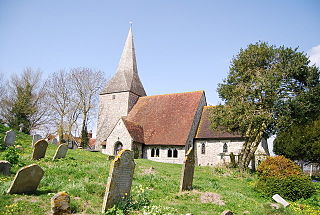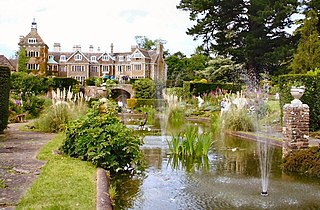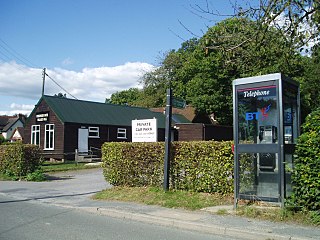
A crozier or crosier is a stylized staff that is a symbol of the governing office of a bishop or abbot and is carried by high-ranking prelates of Roman Catholic, Eastern Catholic, Eastern Orthodox, Oriental Orthodox, Malankara Mar Thoma Syrian Church, and some Anglican, Lutheran, United Methodist and Pentecostal churches.

Duncan James Corrowr Grant was a Scottish painter and designer of textiles, pottery, theatre sets, and costumes. He was a member of the Bloomsbury Group.

Travers John Heagerty, known professionally as Henry Travers, was an English film and stage character actor who specialised in portraying slightly bumbling but amiable and likeable older men.

Charleston, in East Sussex, is a property associated with the Bloomsbury group, that is open to the public. It was the country home of Vanessa Bell and Duncan Grant and is an example of their decorative style within a domestic context, representing the fruition of more than sixty years of artistic creativity. In addition to the house and artists' garden, Charleston hosts a year-round programme of Bloomsbury and contemporary exhibitions in a suite of galleries designed by Jamie Fobert Architects which opened in September 2018. Two restored barns are home to The Threshing Barn café and The Hay Barn where events and workshops are held throughout the year. The Outer Studio at Charleston hosts a permanent display of Bell and Grant's Famous Women Dinner Service, and there is also a shop selling Bloomsbury-inspired art, homeware fabrics, fashion, books and stationery.

Colkirk is a village situated about two miles south of Fakenham in the county of Norfolk, England. Dating from at least the time of the Domesday Book. The village including Oxwick, Pattesley and South Raynham currently (2011) has 588 inhabitants living in 266 dwellings. The village has a church,, in the north west corner of the village, a Village Hall, a church pond, a Camping Land. There is also a thriving village school for students from the age of four to eleven, a lively village Pub called "The Crown" and a playing field for soccer, cricket, rounders and school sports days.

Berwick is a village and civil parish in the Wealden district of East Sussex in England. The village lies immediately to the south of the A27 road between Lewes and Polegate, about three miles (4.8 km) west of the latter. The parish is located in the River Cuckmere floodplain, north of the South Downs.

Greyton is a small town in the Overberg area in the Western Cape, South Africa.

Catsfield is a village and civil parish in the Rother district of East Sussex, England. It is located six miles (9.7 km) north of Bexhill, and three miles (5 km) southwest of Battle.

Fulking is a village and civil parish in the Mid Sussex District of West Sussex, England. The parish lies wholly with the South Downs National Park.

Pyecombe is a village and civil parish in the Mid Sussex District of West Sussex, England. Pyecombe is located 7 miles (11 km) to the north of Brighton. The civil parish covers an area of 887 hectares and has a population of 200, increasing at the 2011 Census to a population of 237.

Nuthurst is a village and civil parish in the Horsham district of West Sussex, England. The north of the parish borders Horsham town, with Nuthurst village 3 miles (5 km) south from the border. Within the parish is the estate and largely 19th-century country house of Sedgwick Park.

Henry Stephenson was a British actor. He generally portrayed amiable and wise gentlemen in many films of the 1930s and 1940s. Among his roles were Sir Joseph Banks in Mutiny on the Bounty (1935) and Mr. Brownlow in Oliver Twist (1948).

The raising of domestic sheep has occurred in nearly every inhabited part of the earth, and the variations in cultures and languages which have kept sheep has produced a vast lexicon of unique terminology used to describe sheep husbandry.

St Nicolas Church is an Anglican church in the Portslade area of the English city of Brighton and Hove. It has 12th-century origins, and serves the old village of Portslade, inland from the mostly 19th-century Portslade-by-Sea area.
"By hook or by crook" is an English phrase meaning "by any means necessary".

The Church of the Transfiguration is the Church of England parish church of the village of Pyecombe, in the Mid Sussex District of West Sussex, England. The mostly 12th- and 13th-century building, in an isolated setting facing the South Downs, has been designated a Grade I Listed building.

A Tapsel gate is a type of wooden gate, unique to the English county of Sussex, which has a central pivot upon which it can rotate through 90° in either direction before coming to a stop at two fixed points. It was named after a Sussex family of bell-founders, one of whom invented it in the late 18th century. Only six examples survive, all within a 10-mile (16 km) radius of Lewes, the county town of Sussex. Tapsel gates have the dual advantage of keeping cattle out of churchyards and allowing the efficient passage of coffins carried to and from the church during burials. The name sometimes is used more generally to describe swivelling gates of a similar design elsewhere.

Chelwood Gate is a small village within the civil parish of Danehill in the Wealden district of East Sussex, England. Its nearest town is Uckfield, which lies approximately 6.6 miles (10.6 km) south-east from the village, just off the A22 road. The village is near the West Sussex border.
Cox & Barnard Ltd was a stained glass designer and manufacturer based in Hove, part of the English city of Brighton and Hove. The company was founded in Hove in 1919 and specialised in stained glass for churches and decorative glass products. Many commissions came from Anglican and Roman Catholic churches in the English counties of East Sussex, West Sussex and Kent. The company was also responsible for six war memorial windows at an Anglican church in Canada, made from shards of glass collected from war-damaged church windows across Europe.
"The Good Shepherd" is the 5th episode of the supernatural drama television series Grimm of season 2 and the 27th overall, which premiered on September 28, 2012, on NBC. The episode was written by Dan E. Fesman, and was directed by Steven DePaul. The series returned to its normal Friday timeslot beginning with this episode.



















